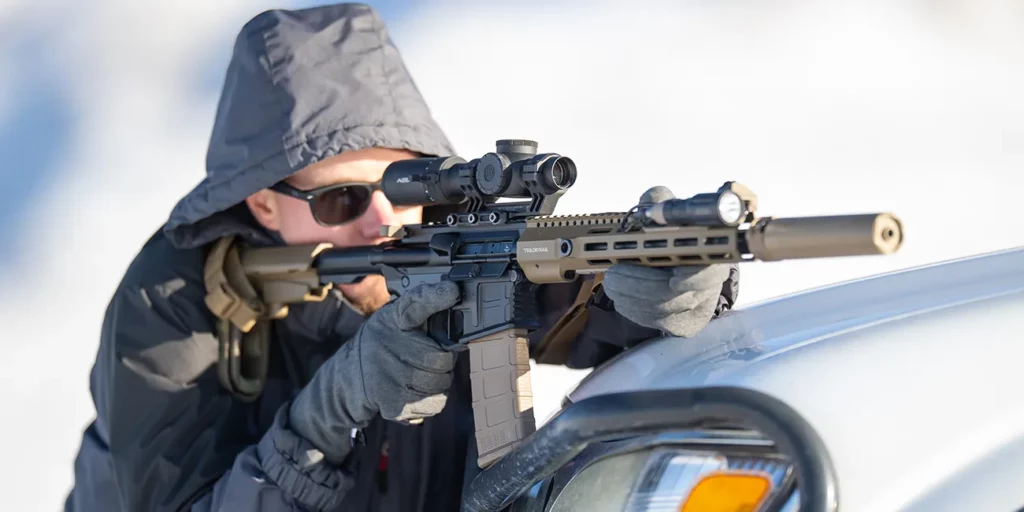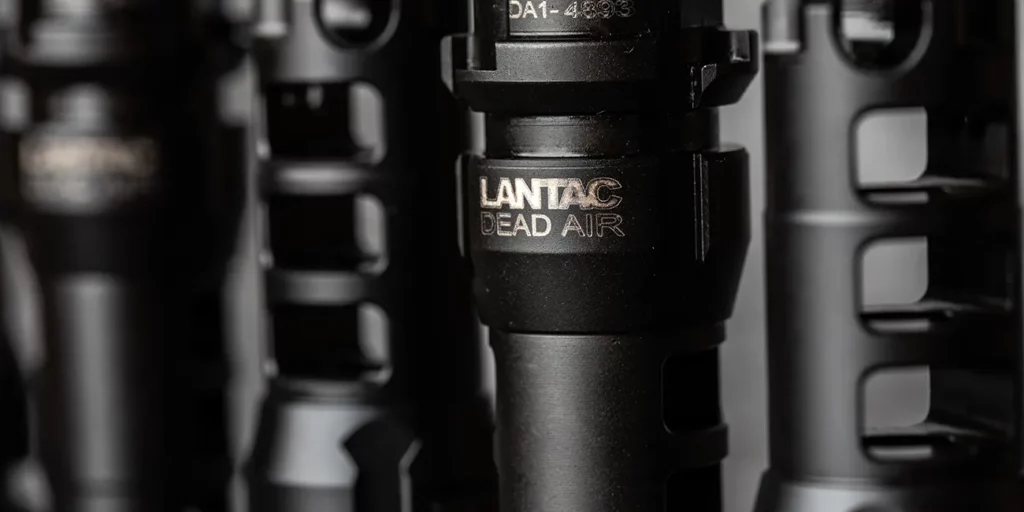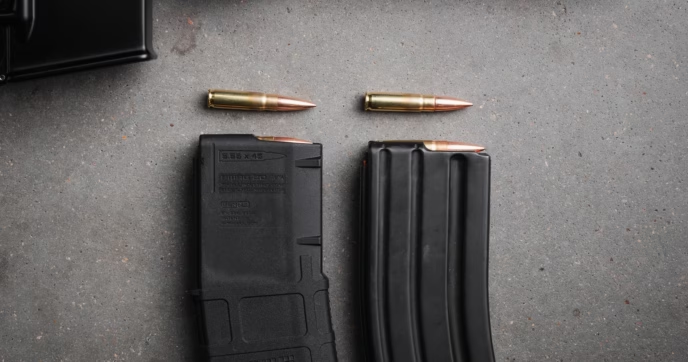Few components of an AR-15 have as much impact on the shooting experience as a muzzle brake. A good AR15 muzzle brake can take the edge off of unpleasant recoil; the best AR15 muzzle brakes can tame even hard-kicking rounds like .50 Beowulf and make shooting them a breeze. Sadly, though, there are some trade-offs.
Effective muzzle brakes can cut felt recoil, reduce split times, and make it easier to spot impacts and trace mirage on long shots, but they can also buffet your shooting partners with hot gas, increase their perceived noise level, and drastically increase your dust and sound signature.
So how do you choose the best AR15 muzzle brake for your rifle? Like with all parts and accessories, mission dictates gear. Below, we’ll cover some of the best muzzle brakes on the market, their pros and cons, and the use cases that make them ideal.

Why a Muzzle Brake?
There’s a whole world of muzzle devices out there: flash hiders, compensators, silencers, etc. Why choose a muzzle brake? The truth is that no one type of muzzle device is truly better than the others, as they all excel at different things. Where muzzle brakes excel, more than any other, is reducing felt recoil.
Flash hiders are great for military rifles where reducing your visibility is important, but they really don’t have anything to offer users at the range or during competition or hunting. Suppressors are great for reducing noise and flash but do little to tame recoil.
Compensators act similarly to muzzle brakes, redirecting gas from the gunshot to change the recoil impulse. A compensator, though, directs the gas upwards, thereby forcing the muzzle down and combating the natural rise we see during shooting. This helps users stay on target and can speed up split times, sometimes considerably, but they don’t actually do much to reduce the recoil felt in the user’s shoulder.
Muzzle brakes use a baffle or series of baffles to harness the gas from a gunshot to push the rifle forward, counteracting the rearward motion created by the shot. We won’t get into the physics of it, but basically pushing the rifle forward while it’s being pushed back by the gunshot cancels out some of the felt recoil, making the rifle feel like it’s kicking less. This can translate into less muzzle rise, much like a compensator.
The downside to a muzzle brake is that the redirected gas is then pushed out primarily to the sides of the operator. This can mean a face full of hot gas for whoever is standing next to you. The gas can also produce a larger dust signature when shooting prone. Some models increase perceived sound, making the rifle seem louder.
One of the less-commonly understood benefits of a muzzle brake is its utility as a mounting platform for a silencer. Many muzzle brakes offer a quick-detach mounting solution for certain suppressors, making it much easier to mount or remove your suppressor and to switch it between multiple rifles. Even beyond that, though, a muzzle brake can serve as a sacrificial baffle, extending the life of your suppressor by bearing the brunt of the impact of any gas or unburnt powder emitted by the gunshot.
Ultimately, every different muzzle device offers different benefits and trade-offs, but there is a reason muzzle brakes have become so commonplace in recent years. For recreational, competition, and even tactical users, muzzle brakes offer a flatter and softer shooting rifle, meaning more rounds on target in a shorter time.

Best AR15 Muzzle Brakes for Recoil Reduction
JP Recoil Eliminator
Want to cut felt recoil down to the absolute bare minimum? The JP Recoil Eliminator is one of the best AR15 muzzle brakes for you.
This monstrous muzzle brake looks like it belongs on a howitzer rather than an AR-15, but we can’t argue with its effectiveness. It uses two wide baffles to redirect as much of the gas as possible to the sides, cutting recoil drastically, especially on larger calibers. The bottom of the brake is wider than the top, which helps to prevent gas from surging downwards and causing a large dust cloud when fired from a prone position.
Shop JP Enterprises Muzzle Devices
The JP Recoil eliminator weighs in at a whopping 6 ounces, nearly double most of the other brakes on our list. Additional weight at the muzzle-end of your rifle is a double-edged sword; on the one hand, that weight will help to reduce muzzle rise, in addition to the recoil-reducing effects of the compensator. On the other, it can also contribute to fatigue if you’re doing a lot of shooting offhand.
For users who don’t mind the extra weight or who do most of their shooting from a supported position, though, the JP Recoil Eliminator is one of the best AR-15 muzzle brakes for minimizing felt recoil.
Precision Armament M4-72
Maybe you do a lot of shooting offhand, though. Maybe you’re looking for something for run-and-gun style competitions where you don’t want a lot of weight at the end of your rifle slowing you down on target transitions. Maybe you just want something a little less ostentatious at the range.
If any of those apply to you, Precision Armament’s M4-72 is exactly what you’re looking for. It’s a lightweight, highly efficient brake that uses a triple baffle design to cut felt recoil significantly. The baffles are slanted steeply backward, which contributes to the effectiveness of the brake but also directs more of the blast backward and less to the sides.
Most operators won’t notice any increased gas coming back at them, but a bystander off to the side or behind you may. You may also want to think twice before putting this on a short-barreled rifle; Precision Armament warns that users may experience excessive blast on bullpups and rifles with barrels shorter than 14.5 inches.
Similar to the JP brake, the M4-72 uses closed-bottom construction to reduce the rifle’s dust signature when shooting prone.

Best AR15 Muzzle Brakes for Mounting a Suppressor
One of the best reasons to opt for a muzzle brake over a compensator or flash hider is for use with a suppressor. The best AR15 muzzle brakes double as sacrificial baffles, which can greatly increase the service life of a silencer. Given the expense and paperwork required for a silencer, replacing a worn-out muzzle brake is much more palatable than a baffle stack.
Expo Arms/Forward Controls Design Single Chamber Brake
Designed by Expo Arms and Forward Controls Design, this single-chamber muzzle brake offers an excellent mounting platform for Dead Air suppressors. The simple but effective single-chamber port offers good recoil mitigation when used as a standalone device and features KeyMo compatibility. This allows users to quickly and repeatably mount a suppressor, making it easy to switch one suppressor between multiple rifles using KeyMo muzzle devices.
Shop Expo Arms/FCD Muzzle Devices
The Expo Arms brake is machined from 4140 chrome-molybdenum steel and nitrided to increase surface hardness and corrosion resistance, making it ideal to bear the impact of the unburnt powder and gas leaving the barrel of your rifle. It also has a pilot hole for users looking to pin and weld it to a 14.5″ or 13.9″ barrel to reach a 16″ overall length.
For a tough-as-nails sacrificial baffle and mounting platform, the Expo Arms Single Chamber Brake is one of the best AR15 muzzle brakes available.
Q Cherry Bomb
Q’s tiny Cherry Bomb muzzle brake is the smallest and lightest on our list. Consequentially, it compromises on recoil mitigation, but still serves as an effective device to protect the baffles of your suppressor and offer quick mounting and detachment.
Q’s design uses 360-degree ports to vent gas, which provides less recoil reduction than directed ports like those found on traditional brakes but makes it a breeze to mount. With no directed ports, you won’t have to waste any time worrying about clocking it correctly.
At only 2 ounces, the Cherry Bomb is barely noticeable on the end of your rifle but still performs admirably as a sacrificial baffle. Basically, if you plan to run a Q silencer on your rifle full time but still want the benefits of a muzzle brake as a mounting platform, the Cherry Bomb is the best AR15 muzzle brake for you.
SureFire SOCOM Muzzle Brake
SureFire is one of the older names in the firearms industry, and a well-respected one. Their suppressors in particular are held in high regard and used by several military units. They do use a proprietary mounting platform, though, so users of their quick-detach suppressors will need a corresponding muzzle device.
Shop All Surefire Muzzle Devices
Enter the SOCOM muzzle brake. This full-featured brake uses a large double-chamber design to reduce recoil impulse and muzzle rise while also serving as a quick-detach mount. The brake is designed with SureFire’s proprietary Impulse Diffusion to combat recoil while minimally increasing side and rearward muzzle blast.
At 3.9 ounces, SureFire’s brake can’t really be called small or light, but it is effective, both at cutting recoil and preserving the lifespan of your suppressor. Similar to the Lantac Dragon, it uses two top ports to add a moderate compensating effect, forcing the muzzle down during live fire.
If SureFire is your pick for a silencer, the SOCOM is the best AR15 muzzle brake for it.

Best AR15 Muzzle Brake Hybrids
Sometimes the best AR15 muzzle brakes aren’t brakes at all; hybrid devices can offer a combination of benefits from all varieties of muzzle devices.
Precision Armament EFAB
It doesn’t look anything like a muzzle brake, a compensator, or a flash hider, but somehow the EFAB is a combination of all three. An acronym for Enhanced Flash Arresting Brake, the EFAB offers intermediate recoil reduction and true flash suppression for a softer-shooting rifle that remains undetectable downrange.
The design isn’t really like any other muzzle device; the EFAB uses a matrix of small ports around most of the circumference of the brake to diffuse the gases generated by a gunshot. The very bottom of the brake is unported to prevent a significant dust cloud from kicking up when shooting prone. Unlike traditional brakes, it doesn’t really result in any significant increase in muzzle blast to the sides of the operator.
While it doesn’t offer any suppressor mounting capability, it is machined out of 416 stainless steel and coated with Ionbond, so it’s certainly designed to last for the long haul.
With its unique combination of features, the EFAB is the best AR15 muzzle brake for users who don’t want to compromise on flash suppression but still want some degree of recoil mitigation.
Lantac Dragon Brake
Lantac’s Dragon is a proven muzzle device that’s enjoyed significant popularity for quite some time now, and with good reason. While not a true muzzle brake, it’s a great jack-of-all-trades device that cuts down on felt recoil and muzzle rise both.
Shop All Lantac Muzzle Devices
The Dragon uses a triple baffle system similar to the M4-72 to reduce felt recoil but augments it with top holes designed to allow gas to escape directly upwards as well, adding a compensator function to help tame muzzle rise. These two systems technically make it a hybrid device, rather than a true brake, but most of its function is to reduce felt recoil.
Lantac claims its Short Energy Pulse system cuts the length of time of the recoil impulse, which helps prevent the effects of rapid fire from compounding. Anyone who has ever fired an automatic knows they have a tendency to “walk” off target, but the same effect can be seen in rapidly-fired semi-automatics as well. Lantac’s system helps to combat this, making it an excellent option for users who really just want to shoot fast.

Conclusion
“Best” can mean a lot of different things to different people. The best AR15 muzzle brake is always going to be the one that meets your specific needs while minimizing trade-offs.
For recreational users who are just looking to soften the blow to their shoulder, the Recoil Eliminator or M4-72 will do perfectly, depending on your shooting style and how much weight you can tolerate. Users looking for suppressor compatibility, on the other hand, would be best served by a SOCOM, Cherry Bomb, or Expo Arms KeyMo brake.
For those who really need flash suppression for use with night vision or in dangerous environments, a hybrid design like the EFAB offers a useful compromise of features. At the end of the day, it’s all about finding the right brake for your rifle, your shooting style, and your needs.



